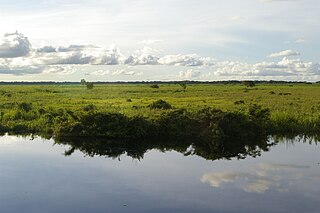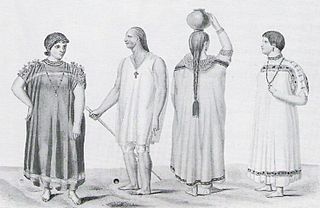
Guarani are a group of culturally-related indigenous peoples of South America. They are distinguished from the related Tupi by their use of the Guarani language. The traditional range of the Guarani people is in present-day Paraguay between the Uruguay River and lower Paraguay River, the Misiones Province of Argentina, southern Brazil once as far north as Rio de Janeiro, and parts of Uruguay and Bolivia.
The Tupi people were one of the most numerous peoples indigenous to Brazil, before colonisation. Scholars believe that while they first settled in the Amazon rainforest, from about 2,900 years ago the Tupi started to migrate southward and gradually occupied the Atlantic coast of Southeast Brazil.

Beni, sometimes El Beni, is a northeastern department of Bolivia, in the lowlands region of the country. It is the second-largest department in the country, covering 213,564 square kilometers, and it was created by supreme decree on November 18, 1842 during the administration of General José Ballivián. Its capital is Trinidad.

The Kamayurá are an indigenous tribe in the Amazonian Basin of Brazil. Their name is also spelled Kamayura and Kamaiurá; it means "a raised platform to keep meat, pots and pans." The Kamayurá language belongs to the Tupi–Guarani family.

The Apiacá, or Apiaká, are an indigenous people of Brazil, who live in northern Mato Grosso, near the border of Pará. They speak an Apiacá language that is a subgroup part of the Tupi-Guarani languages, though many today speak Portuguese. Prior to the 19th century, the Apiacá were a warlike tribe with a heavily agricultural culture. Around the mid 19th century, their numbers began to decline. This decrease coincided with the contact of European settlers in Brazil. Though thought to be extinct, their numbers, today, are increasing. In 2001, there were only 192 Apiaká. As of 2009, there are a thousand Apiaká people.

The Tsimané, also known as the Tsimane' or Chimane, are an indigenous people of lowland Bolivia, living chiefly in the Beni Department municipalities of San Borja, San Ignacio de Moxos, Rurrenabaque, and Santa Ana del Yacuma. The Tsimané are the main residents of the T’simane Council Territory and the Pilón Lajas Reserve. They are primarily a subsistence agriculture culture, although hunting and fishing contribute significantly to many of the settlements' food supply. Those Tsimané living in the Reserve are affiliated with the multiethnic Consejo Regional Tsimane Moseten (CRTM), which holds the title to the Reserve as a Native Community Land or TCO.

Paraguayan Indian art is the visual art created by the indigenous peoples of Paraguay. While indigenous artists embrace contemporary Western art media, their arts also include pre-Columbian art forms. Indian art of aboriginal origin includes ceramics, baskets, weaving and threading, feather art and leather work. Indian art of a hybrid nature includes the embroideries, lace, woodcarving and different metal products. Paraguay is particularly known for its indigenous featherwork and basket weaving.

The Kalapalo are an indigenous people of Brazil. They are one of seventeen peoples who inhabit the Xingu National Park in the Upper Xingu River region of the state of Mato Grosso. They speak the Amonap language, a Cariban language, and are one of four peoples speaking languages in this family in the area. They have a population of 569 as of 2010.

Chané is the collective name for the southernmost Arawakan-speaking peoples. They lived in the plains of the northern Gran Chaco and in the foothills of the Andes in Paraguay, Brazil, Bolivia, and Argentina. The historical Chané are divided into two principal groups. The Chané proper who lived in eastern Bolivia and the Guaná who lived in Paraguay and adjacent Brazil. Twenty-first century survivors of the Chané are the Izoceno people of Bolivia and 3,034 descendants reported in Argentina by the 2010 census. Survivors of the Guaná are the Tereno and the Kinikinao both of Mato Grosso do Sul province in Brazil.

The Kayabí or Kaiabi are an indigenous people of Brazil inhabiting the northern state of Mato Grosso. The primarily live in the Xingu Indigenous Park and the Indian Reservation of Apiaká-Kayabi south of Pará. There are approximately 1300 Kayabí living on the Xingu Indigenous Park. They are known by a number of names; Caiabi, Parua, Maquiri, Kawaiwete and many more romanizations of the word Kaiabi.

The Guarayos are an indigenous group living in their ancestral land in eastern Bolivia. They are located north of the department of Santa Cruz. The current population of the Guarayo group in Bolivia is 12,000. They primarily speak Guarayu, and 70% of the population is Roman Catholic with the remaining 30% practicing ethnic religions. Guarayu comes from the language of Guaraní as it belongs in the Tupí Family. They are known to be predominantly agricultural as much of their culture and lifestyle relies on their land.

Maní, a Tupí myth of origins, is the name of an indigenous girl with very fair complexion. The Amazonian legend of Maní is related to the cult of Manioc, the native staple food that sprang from her grave.

The Chiquitano or Chiquitos are an indigenous people of Bolivia, with a small number also living in Brazil. The Chiquitano primarily live in the Chiquitania tropical savanna of Santa Cruz Department, Bolivia, with a small number also living in Beni Department and in Mato Grosso, Brazil. In the 2012 census, self-identified Chiquitanos made up 1.45% of the total Bolivian population or 145,653 people, the largest number of any lowland ethnic group. A relatively small proportion of Bolivian Chiquitanos speak the Chiquitano language. Many reported to the census that they neither speak the language nor learned it as children. The Chiquitano ethnicity emerged among socially and linguistically diverse populations required to speak a common language by the Jesuit Missions of Chiquitos.

The Witoto are an indigenous people in southeastern Colombia and northern Peru.
The Machinere are an indigenous people of Brazil, Bolivia, and Peru. They live along the Acre River in Bolivia. In Brazil they mostly live in the Mamoadate Indigenous Territory, although some live in the Chico Mendes Extractivist Reserve, both in Acre.delete
Warázu, also known as Pauserna or Guarasugwé (Guarasú'we), is a moribund Tupi–Guaraní language of Brazil. It was also formerly spoken in Bolivia. It is spoken by the Guarasugwé people, who were estimated to number 125 according to a census in 2012.
The Sirionó are an indigenous people of Bolivia. They primarily live in the forested northern and eastern parts of Beni and northwestern Santa Cruz departments of Bolivia. They live between the San Martín, Negro Rivers, and the Machado River.

Around 650 AD, Jamaica was colonized by the people of the Ostionoid culture, who likely came from South America. Alligator Pond in Manchester Parish and Little River in St. Ann Parish are among the earliest known sites of this Ostionoid culture, also known as the Redware culture. These people lived near the coast and extensively hunted turtles and fish.

The Ava Guaraní are an Indigenous peoples formerly known as Chiriguanos or Chiriguano Indians who speak the Ava Guarani and Eastern Bolivian Guaraní languages. Noted for their warlike character, the Chiriguanos retained their lands in the Andes foothills of southeastern Bolivia from the 16th to the 19th centuries by fending off, first, the Inca Empire, later, the Spanish Empire, and, still later, independent Bolivia. The Chiriguanos were finally subjugated in 1892.

Wanám,, were a group of Amerindians once native to the region of southern Rondônia in Brazil. They lived on the Cautarinho, Sao Miguel and Manoel rivers near their confluence with the Guaporé. Around 1914 there were 300 Wanám. The rubber booms of the twentieth century destroyed the tribe because of the violence and diseases brought in by neo-Brazilians. The surviving Wanám went to live with neighboring groups Kabixí living on the São Miguel River. Although the Wanám people did not survive, their language did, at least among the Kabixí Indians.
















